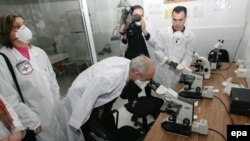It is a medical paradox that has public-health workers very worried. Powerful drugs meant to cure people of tuberculosis are indirectly killing them instead.
And the World Health Organization (WHO) is raising the alarm.
Second-Line Drugs
For years, doctors have been battling multi-drug resistant cases of tuberculosis using ever-stronger pharmaceuticals called second-line drugs.
But if those strong pharmaceuticals are not used as prescribed, they can give rise to a new strain of extreme drug-resistant tuberculosis.
And that has no cure.
"The treatment of TB, in general, has to follow some fundamental principles," says Ernesto Jaramillo, a WHO medical officer at the Johannesburg conference. "First of all, the treatment regimen has to be properly designed and should consist of a cocktail with the right drugs, that should be delivered in the right way. If medical doctors prescribe the wrong drugs, and or if the patient does not take the drugs properly, then the obvious consequence is that -- over time -- drug resistance develops."
A recent outbreak in South Africa of what scientists call extreme drug-resistant tuberculosis, or XDR-TB, killed 52 out of 53 patients infected.
Eastern Europe, Former Soviet Union
In Eastern Europe and the former Soviet Union, where there has been a resurgence of tuberculosis, cases of the extreme drug-resistant variant are rising fast.
Latvia is one example. According to the World Health Organization, it has one of the highest rates. Every fifth case of multi-drug resistant tuberculosis in the country has already morphed into the extreme drug-resistant type.
Russia, Ukraine, and the Central Asian countries, where tuberculosis cases among prisoners have reached epidemic proportions, could soon face the same problem.
This is largely due to a breakdown of the health services in the post-Communist era.
Complex Treatment
Patients who suffer from multi-drug resistant tuberculosis have to take a cocktail of medicines for a long period of time. That is expensive and requires close doctor supervision.
If treatments are skipped or medicines are taken out of sequence, the disease is not cured and can metamorphose into the extreme drug-resistant variety.
Jaramillo says the meeting in Johannesburg will start working on guidelines for health-care workers worldwide, to stop the rise of extreme drug resistant tuberculosis.
In the meantime, he says the most important thing doctors and patients can do is to follow the precise course of treatment. Jaramillo emphasizes that this will save money and lives in the long run.
“What we are going to do is to set up a task force that will be reviewing the current situation and making precise recommendations by the end of the year about how to tackle [extreme drug-resistant TB]," he says. "But in the meantime, what we are strongly recommending is to ensure that second-line drugs -- the drugs used to treat [multi-drug resistant] TB -- are properly used. The rational use of second-line drugs is the most powerful way to prevent the creation of extreme drug-resistant TB."
Working With Drug Companies
The WHO is also trying to persuade pharmaceutical companies to offer discounted drugs to countries in need, to avoid an epidemic of extreme drug-resistant tuberculosis, before it is too late.
"There has been important progress in recent years," Jaramillo says. "One major pharmaceutical company has embarked on transferring technology for producing two key drugs. However, the treatment regimens for multi-drug resistant TB consist of at least four drugs. So although there is progress it is still not enough for what we need."
In one piece of good news earlier this year, U.S. tycoon Bill Gates announced a gift of $600 million to fund antituberculosis programs around the world.
The UN On AIDS
The United Nations has issued its annual report on the AIDS epidemic. Here are some of its findings:
- There are currently an estimated 40.3 million people living with HIV, the virus that causes AIDS. Of those, 17.5 million are women and 2.3 million are children under the age of 15.
- There were an estimated 4.9 million new HIV infections in 2005, including 700,000 children under the age of 15.
- An estimated 3.1 million people, including 570,000 children, died of AIDS in 2005.
- According to the report, more than 25 million people have died of AIDS worldwide since the disease was recognized in 1981.
- In Eastern Europe and Central Asia, the number of HIV-positive people reached 1.6 million in 2005, up from 1.2 million in 2003. The bulk of people living with HIV in the region are in the Russian Federation and Ukraine. "Ukraine's epidemic continues to grow, with more new HIV infections occurring each year, while the Russian Federation has the biggest AIDS epidemic in all of Europe," the report states. A private Russian survey cited in the report found "no postive changes in sexual behaviour, with condom use decreasing slightly among people in their twenties."
- In Central Asia, Uzbekistan and Kazakhstan have seen the most dramatic increases of HIV infections. In the Caucasus, the situation is described "relatively stable."
See also:
Central Asia: AIDS Project Seeks To Avert Epidemic
Eastern Europe: European Commission Warns Of 'Resurgent' HIV/AIDS Epidemic
Listen to a short interview by RFE/RL's Tajik Service with Gregory Henning Mikkelsen, director of EU team for a joint EU/UN AIDS initiative. In the November 21, 2005, interview, Mikkelsen describes the epidemic in Central Asia.Real Audio Windows Media


















